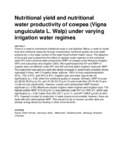Nutritional yield and nutritional water productivity of cowpea (Vigna unguiculata L. Walp) under varying irrigation water regimes
Date
2020-07Author
Kanda, Edwin Kimutai
Senzanje, Aidan
Mabhaudhi, Tafadzwanashe
Mubanga, Shadrack Chisenga
Metadata
Show full item recordAbstract
There is a need to mainstream traditional crops in sub-Saharan Africa, in order to tackle food and nutritional insecurity through incorporating nutritional quality into crop water productivity, in the wider context of the water-food-nutrition-health nexus. The objective of the study was to determine the effect of irrigation water regimes on the nutritional yield (NY) and nutritional water productivity (NWP) of cowpea under Moisture irrigation (MTI) and subsurface drip irrigation (SDI). We hypothesized that NY and NWP of cowpea were not different under MTI and SDI and that deficit irrigation improved NWP. The experiment was laid as a split-plot design arranged in randomized complete blocks, replicated 3 times, with 3 irrigation water regimes: 100% of crop evapotranspiration (ETc), 70% of ETc, and 40% of ETc. Irrigation type and water regime did not significantly (p > 0.05) affect the nutritional quality of cowpea. Similarly, NWP of crude fat (28.20-39.20 g.m(-3)), ash (47.20-50.70 g.m(-1)) and crude fibre (30.70-48.10 gm(-1)) did not vary significantly. However, protein and carbohydrate NWP showed significant (p < 0.05) differences across irrigation water regimes and irrigation type. The highest protein NWP (276.20 g.m(-1)) was attained under M71 at 100% ET, which was significantly (p < 0.05) higher than SDI (237.1 g.m(-1) ) and MTI (189.8 g.m(3)) at 40% ETc. Cowpea is suited for production in water-scarce environments; however, there are trade-offs with carbohydrate NWP. This should not be of concern as often diets are already energy-dense but lacking in other micronutrients.
URI
http://dx.doi.org/10.17159/wsa/2020.v46.i3.8651http://www.scielo.org.za/scielo.php?script=sci_arttext&pid=S1816-79502020000300005
http://r-library.mmust.ac.ke/123456789/1516
Collections
- Gold Collection [989]

